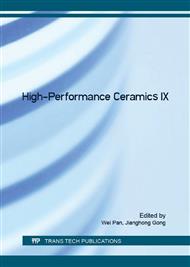p.695
p.701
p.706
p.710
p.714
p.718
p.723
p.727
p.733
Synthesis and Antibacterial Activities of Ag/ZnO Nanoparticles
Abstract:
Ag/ZnO nanoparticles with different Ag concentrations were fabricated through sol-gel method under 500 °C for 60 min with a heating rate 5 °C·min-1. The phase, the crystallographic structure and the surface topography of the Ag/ZnO nanoparticles were charactered by XRD and SEM. The antibacterial activities of the Ag/ZnO nanoparticles were performed by disc diffusion method. The results indicate that the as-prepared Ag/ZnO nanoparticles display great antibacterial activity than ZnO nanoparticle without Ag doping. And Ag/ZnO nanoparticles with 5 mol% Ag concentration show more excellent antibacterial activity toward S.aureus, B. subtilis, E. coli and P. aeruginosa with diameters zones of inhibition 21.7, 18.5, 18.4 and 17.8 mm than other Ag/ZnO nanoparticles. And the mechanism of ZnO antibacterial activity is discussed.
Info:
Periodical:
Pages:
714-717
Citation:
Online since:
July 2016
Authors:
Keywords:
Price:
Сopyright:
© 2016 Trans Tech Publications Ltd. All Rights Reserved
Share:
Citation:


